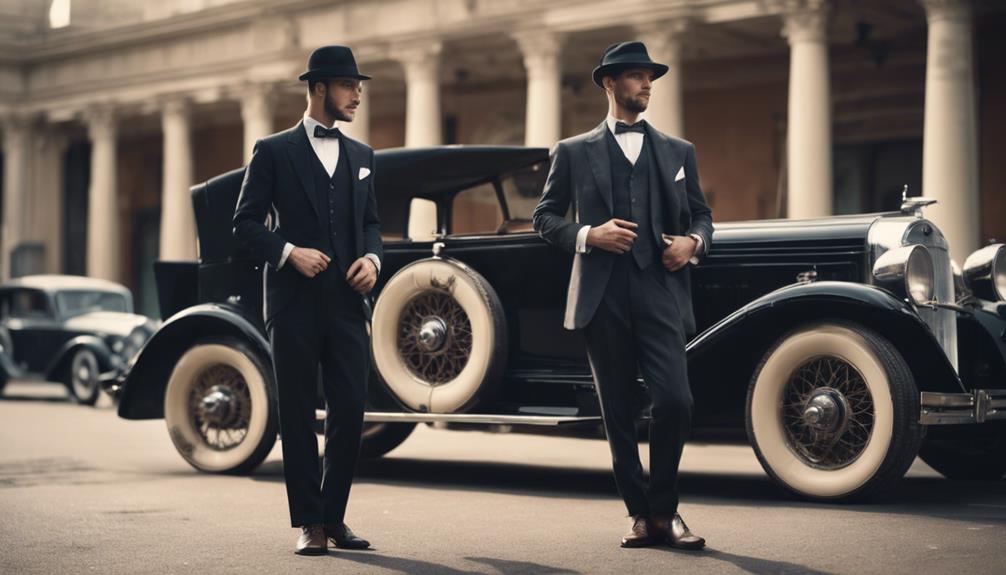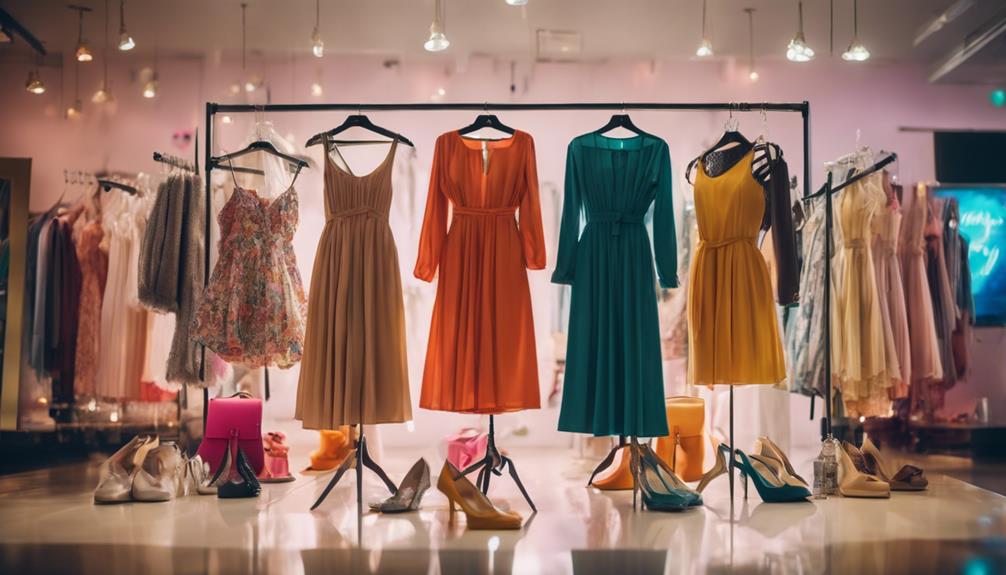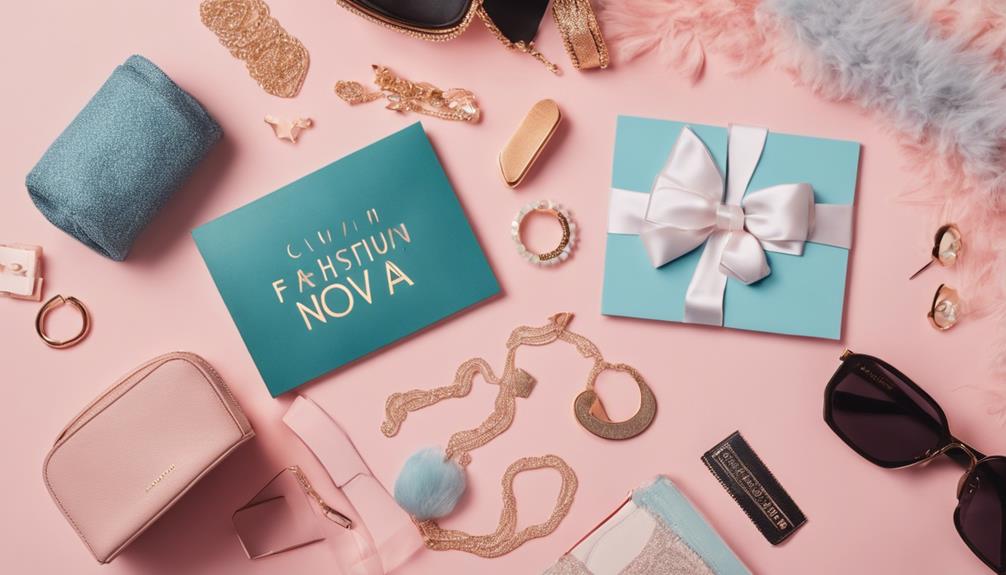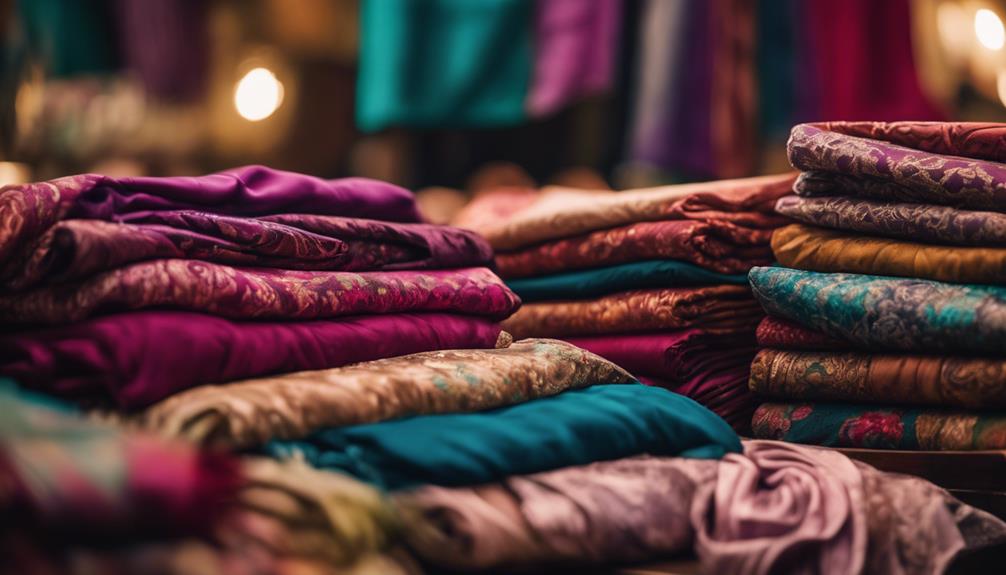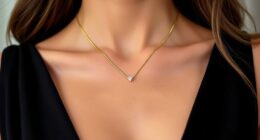In the lively 1920s, men’s fashion underwent a transformation with stylish trends that mirrored the jazz culture of the era. The era saw the rise of three-piece suits that included tailored jackets, matching waistcoats, and high-waisted trousers. Lightweight fabrics such as linen and bold patterns gained popularity, offering a way to showcase individuality and sophistication. Accessories like pocket squares and bow ties added a touch of flair. The influence of jazz music sparked creativity in men’s fashion, resulting in trendy yet comfortable attire. Dive into the world of 1920s fashion to discover tips, modern interpretations, and ideas to enhance your wardrobe inspired by this iconic decade!
Key Takeaways
- The three-piece suit, featuring a tailored jacket, waistcoat, and high-waisted trousers, epitomizes the dapper style of the 1920s men's fashion.
- Bold patterns and vibrant colors became popular, breaking away from traditional dark palettes and allowing for personal expression in menswear.
- Lightweight fabrics like linen and tweed provided comfort and movement, essential for the active lifestyle influenced by jazz music and dance.
- Accessories like pocket squares, bow ties, and vibrant hats enhanced outfits, showcasing individuality and flair in 1920s men's fashion.
Origin and historical background of the fashion trend/style
In the 1920s, tailoring techniques transformed, allowing men to embrace more stylish and comfortable fits.
The rise of jazz music and dance also influenced fashion choices, encouraging bolder styles and a sense of freedom.
As you explore this era, you'll see how these elements shaped the iconic looks of the Roaring Twenties.
Transformation of Tailoring Techniques
The 1920s revolutionized tailoring techniques, moving away from the rigid styles of the Victorian era to embrace looser silhouettes that celebrated comfort and modern elegance. This transformation marked a significant shift in menswear, as you began to see the rise of the three-piece suit, which featured a matching waistcoat. This addition allowed for a more sophisticated and layered look, appealing to men across all social classes.
Tailoring techniques evolved to incorporate wide lapels and lower buttoning stances on jackets, reflecting a relaxed yet stylish approach influenced by the cultural changes following World War I. Lightweight fabrics like linen and flannel gained popularity, offering better movement and comfort, especially during warmer months.
Moreover, the era encouraged self-expression through fashion, as bold patterns and colors, such as pinstripes and pastel hues, became more common. This departure from traditional dark palettes meant that men could showcase their individuality with confidence.
The 1920s set the stage for a more modern approach to menswear, blending elegance with an emphasis on comfort, paving the way for future fashion trends.
Jazz Age Music and Dance
Emerging alongside the transformation in menswear, the Jazz Age brought a vibrant new culture defined by lively music and dynamic dance that influenced fashion choices of the time. The rise of jazz music, spearheaded by legends like Louis Armstrong and Duke Ellington, created a cultural phenomenon that celebrated a carefree spirit. This music wasn't just a backdrop; it shaped the societal attitude of the 1920s, encouraging self-expression and a departure from traditional norms.
Dance styles like the Charleston took the world by storm, allowing men and women to express their individuality through movement. As dance halls filled with energetic crowds, the pulsing rhythms of jazz inspired new fashion trends. You'd see men embracing dapper styles, opting for sharp suits and stylish accessories that echoed the lively atmosphere.
The advent of radio and phonographs made jazz accessible to everyone, cementing its place as the soundtrack of this dynamic era.
As you explore the Jazz Age, remember that the music and dance not only defined entertainment but also ignited a revolution in how men approached fashion, fostering a sense of freedom and creativity in their wardrobe choices.
Key Characteristics
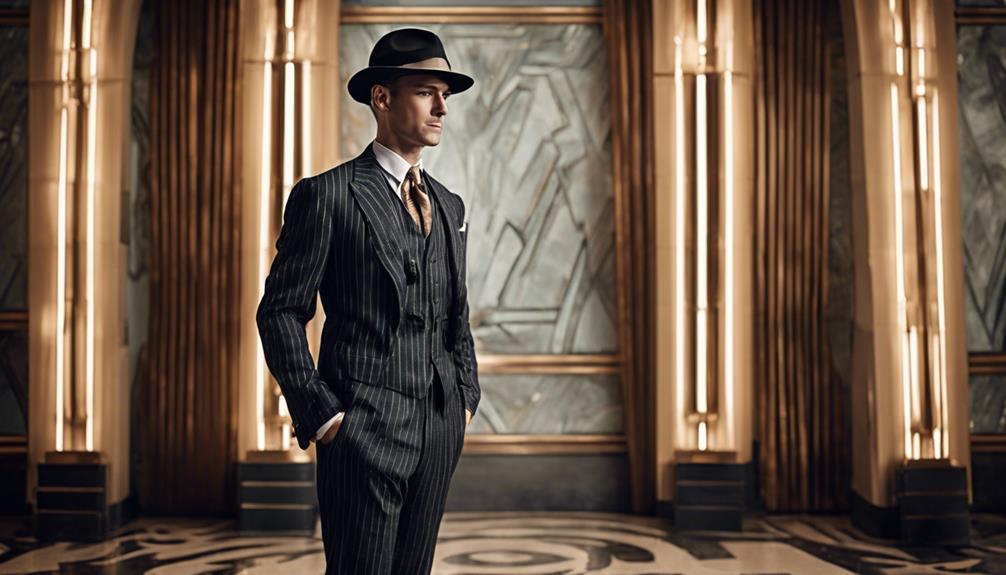
When you think about 1920s men's fashion, bold patterns and stripes immediately come to mind, adding a lively touch to your wardrobe.
Tweed and linen fabrics offered both style and comfort, while pastel hues broke the mold of traditional dark colors.
The three-piece suit became essential for a polished appearance, showcasing the era's emphasis on tailored elegance.
Bold Patterns and Stripes
Bold patterns, especially stripes, define 1920s men's fashion, adding flair and personality to every outfit. During the Jazz Age, men embraced bold patterns, integrating them into their wardrobes with confidence. Vertical stripes, in particular, became a favorite for their elongating effect, flattering the silhouette beautifully.
You'll find high-waisted trousers adorned with plaid and checks, perfectly complementing vibrant shirt styles that allowed for personal expression. Dress shirts shifted dramatically, featuring daring hues and patterns like checks and florals, which encouraged men to showcase their individuality.
Accessories also played a vital role in this style revolution. Ties and pocket squares embraced bold patterns, with plaids and stripes enhancing the overall look. The combination of tailored separates allowed you to mix and match, creating a distinctive and stylish ensemble that stood out in any social setting.
The allure of bold patterns and stripes wasn't just about looking good; it was a statement of confidence and creativity, reflecting the energetic spirit of the Roaring Twenties. So, don't shy away from incorporating these eye-catching elements into your wardrobe; they're key to capturing that dapper style of the era!
Tweed, Linen, and Pastel Hues
Tweed, linen, and pastel hues became essential elements of 1920s men's fashion, offering a fresh and vibrant alternative to the darker tones of previous years.
Tweed, known for its durability and texture, emerged as a favored fabric for tailored jackets, perfect for both country outings and urban settings. The lightweight and breathable qualities of linen made it a popular choice for warmer seasons, often featured in relaxed menswear styles that catered to comfort without sacrificing sophistication.
Pastel hues began to gain traction towards the end of the decade, allowing you to express individuality and style through softer color palettes. The combination of tweed and linen in these vibrant colors reflected the era's shift towards a more relaxed approach to menswear.
High-waisted trousers paired with tailored jackets not only showcased a youthful sophistication but also helped redefine men's fashion norms of the time.
Three-Piece Suit Essentials
The three-piece suit epitomizes the sophistication of 1920s men's fashion, combining a tailored jacket, matching waistcoat, and high-waisted trousers for a polished look. This classic ensemble showcases tailored elegance, with the tailored jacket featuring broad lapels and a double-breasted design that creates a strong silhouette, flattering your frame.
The waistcoat, often made from contrasting fabrics or patterned materials, adds a layer of visual interest, allowing you to express your personal style. High-waisted trousers, with details like cuffs and pleats, guarantee a comfortable yet stylish fit, adhering to the decade's fashion principles.
To elevate your three-piece suit, don't forget the essential accessories. Pocket squares inject a touch of sophistication, while bow ties and silk scarves provide personality and flair. These elements not only enhance your overall appearance but also reflect the individuality that was celebrated during the Roaring Twenties.
Modern Interpretation
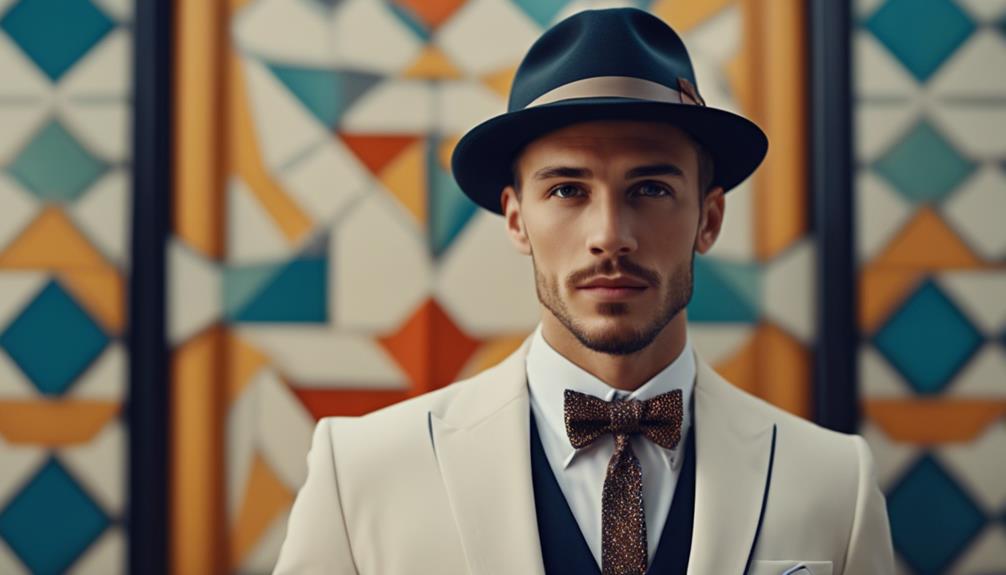
When you look at modern interpretations of 1920s fashion, you'll notice a strong revival of tailored suits that echo the elegance of the era.
Savile Row tailors are leading the charge, blending traditional craftsmanship with contemporary flair.
Plus, the influence of Hollywood stars from that time continues to inspire today's style choices, giving you plenty of options for a dapper look.
Contemporary Tailored Suit Revival
Drawing from the iconic styles of the 1920s, contemporary tailored suits now blend classic elegance with modern flair, making a striking statement in today's fashion landscape.
You'll find that these suits emphasize structured silhouettes and wide lapels, reminiscent of the era's three-piece ensembles. High-waisted trousers add a touch of sophistication while enhancing your overall profile.
Modern interpretations often incorporate vibrant colors and bold patterns, echoing the Roaring Twenties' lively palette. Navy, gray, and pastel hues are making a strong comeback, allowing you to express your personality through your wardrobe. Lightweight fabrics like linen and cotton are now favored for comfort, ensuring you look sharp without sacrificing ease.
Accessories play a vital role in this revival. Pocket squares, bow ties, and vintage-inspired hats are being reintroduced, providing a stylish nod to the sophistication of the past.
This revival of the contemporary tailored suit reflects a broader cultural trend towards dressing with intention and style, seamlessly blending historical elements with modern aesthetics.
Savile Row Tailors' Influence
Savile Row tailors' influence on 1920s fashion continues to shape modern menswear, emphasizing precision fit and quality craftsmanship that today's discerning shoppers appreciate. The tailored suits crafted by Savile Row artisans established a benchmark for excellence, and their legacy lives on in contemporary designs.
You'll find that the double-breasted jacket, once a hallmark of 1920s style, remains a staple, showcasing a preference for structured silhouettes. Modern interpretations draw heavily from Savile Row's iconic elements, such as peaked lapels and high-waisted trousers, seamlessly blending tradition with innovation.
The bespoke tailoring that originated from this legendary street guarantees that individuality and personalization are at the forefront of men's fashion today. Fabrics like fine wool, tweed, and cashmere, once favored by Savile Row tailors, continue to inspire designers, who combine these traditional materials with fresh ideas.
The meticulous attention to detail that defined bespoke tailoring in the past is just as relevant now, as it enhances the overall experience of wearing a tailored suit. This enduring influence guarantees that modern menswear pays homage to the craftsmanship and style of the Roaring Twenties.
Hollywood Stars of the Era
Hollywood stars like Fred Astaire and Rudolph Valentino set the fashion stage in the 1920s, effortlessly blending elegance with comfort in their tailored suits. These fashion icons defined a new era of men's style, where sleek lines and lightweight fabrics took center stage.
Astaire's impeccable tailoring showcased a perfect mix of style and functionality, encouraging you to adopt similar looks for both formal and casual occasions.
Valentino, with his slicked-back hair and dapper suits, epitomized the romantic allure of the decade, radiating sophistication and charm. As Hollywood's influence grew, so did its ability to shape cultural attitudes toward fashion, making tailored suits a staple for men everywhere.
The artistry of Art Deco also played a significant role, as its bold geometric designs and luxurious materials reflected the glamour of the age. This modernized image of Hollywood stars inspired you to embrace a sense of sophistication in your wardrobe.
Styling Tips
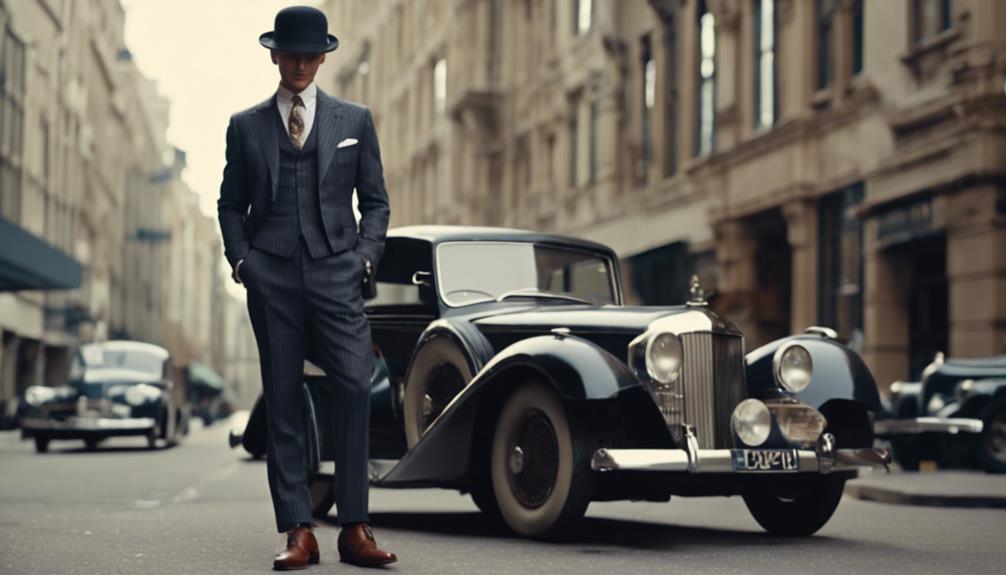
When it comes to styling your 1920s look, think about incorporating a tailored three-piece suit with vintage-inspired layers.
You can play with bold patterns and textures to create a unique ensemble that captures the era's essence.
Let's explore how to effectively mix and match these elements for a standout appearance.
Three-Piece Suit Components
A well-fitted three-piece suit, featuring a tailored jacket, stylish waistcoat, and smart trousers, instantly elevates your wardrobe and exudes timeless sophistication. To achieve that polished look, focus on the details of each component. Your tailored jacket should ideally have wide lapels and a double-breasted style, reflecting the strong silhouette that defined the 1920s.
Pair your jacket with a waistcoat that adds a pop of personality—consider bold patterns or contrasting colors to make a statement in formal attire. Don't forget about the trousers; high-waisted trousers with pleats and cuffs not only provide comfort but also highlight the fashionable ankle-revealing cut.
Accessories complete your ensemble. A pocket square, bow tie, or necktie can enhance your overall appearance, while a fedora or bowler hat adds an extra touch of dapper flair. These accessories tie the look together, ensuring you stand out at any event.
Embrace this classic style, and you'll confidently embody the elegance of the Roaring Twenties while making it your own.
Vintage-inspired Layering Techniques
Building on the elegance of a well-fitted three-piece suit, vintage-inspired layering techniques can elevate your style while adding versatility to your wardrobe.
Start with a tailored jacket over your waistcoat and trousers for a polished look. For an extra touch, incorporate a vibrant patterned dress shirt beneath your jacket or waistcoat to introduce a pop of color and visual interest.
Consider adding a sweater vest for a casual yet sophisticated layer during cooler days. This piece not only provides warmth but also complements your vintage-inspired ensemble beautifully.
When layering, don't shy away from mixing textures; pair a wool suit with a cotton shirt and a silk tie to create depth and character in your outfit.
Accessories play an essential role in enhancing your style. Use pocket squares or silk scarves layered atop your jacket to reflect your personal flair and complete your polished look.
Remember, layering isn't just about warmth; it's about crafting an eye-catching, dapper appearance that pays homage to the chic styles of the Roaring Twenties.
Embrace these techniques to showcase your unique style while celebrating vintage charm.
Layering Vintage Patterns Effectively
Layering vintage patterns effectively adds visual intrigue to your outfit, but it's important to choose a dominant pattern that harmonizes with complementary ones to prevent clashing. Start with a bold pattern, like stripes, as your foundation. Pair it with checks that share a similar color palette, such as soft pastels, to create a cohesive and stylish look.
Mixing textures is significant in layering; combine lightweight fabrics like cotton shirts with heavier materials like tweed jackets. This approach not only adds depth but also guarantees comfort throughout the day.
Accessories play a fundamental role in enhancing your ensemble. Consider pocket squares or ties that introduce additional patterns, but make sure they echo your overall theme for a polished finish.
Shopping Guide
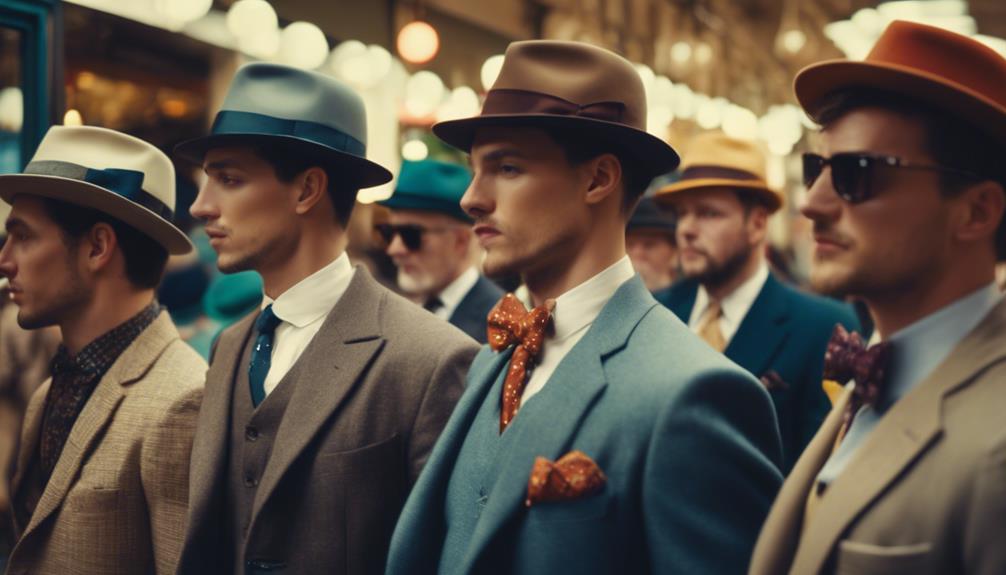
When you're on the hunt for 1920s-inspired men's fashion, focus on finding tailored three-piece suits that capture the essence of the Roaring Twenties. These suits typically include a jacket, trousers, and a waistcoat, giving you that classic dapper look. Look for vibrant color palettes like navy, gray, pastel blue, and mustard yellow, which were all the rage during that era.
Accessorizing is key to completing your formal style. Add bow ties, pocket squares, cufflinks, and silk scarves to elevate your outfit while reflecting the sophistication of the time. Don't overlook your choice of trousers; opt for high-waisted options with cuffs and pleats to stay true to the 1920s aesthetic.
When it comes to footwear, stylish choices like Oxfords or two-tone brogues can really tie your look together.
Upcycling Vintage Clothing Ideas
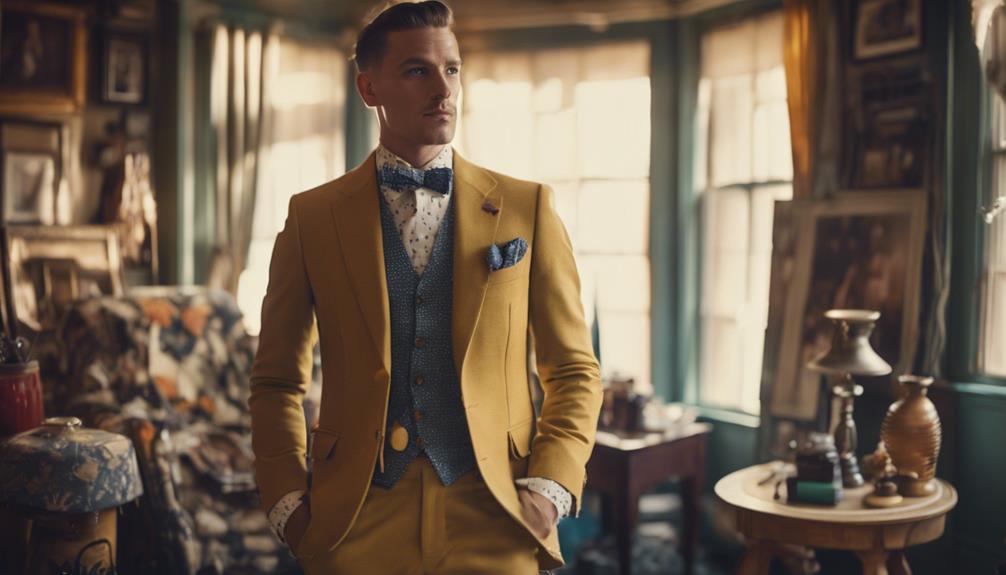
You can easily upcycle vintage clothing from the 1920s by repurposing old suit fabrics into modern jackets or vests that maintain the era's style.
Don't forget to contemplate vintage accessories like bow ties and pocket squares; they can add a unique touch to your contemporary outfits.
Repurposing Old Suit Fabrics
Repurposing old suit fabrics from the 1920s offers a stylish way to create unique accessories that celebrate vintage elegance while promoting sustainable fashion. By upcycling vintage suit fabrics, you can craft modern accessories like vests, bow ties, and pocket squares that embody the dapper aesthetics of the Roaring Twenties. High-quality materials such as wool and tweed provide durability and charm, ensuring your creations maintain a touch of 1920s elegance.
Incorporating vibrant patterns and textures from these suits allows for creative layering within your contemporary wardrobe. This not only enhances your personal style but also adds a historical flair to your outfits.
Engaging in DIY projects, like transforming old suit jackets into chic bags or tailored vests, offers an opportunity to hone your sewing skills while preserving the craftsmanship of vintage menswear.
Repurposing Accessories for Modern Wear
Transforming vintage accessories from the 1920s into modern wear not only revitalizes your wardrobe but also pays homage to the era's distinctive style. You can easily integrate vintage accessories like pocket squares into your modern outfits, adding a touch of dapper sophistication while keeping their historical charm alive. Fedora hats and homburgs, once staples of 1920s fashion, can elevate your casual attire, creating a unique blend of vintage flair with contemporary style.
Consider upcycling old silk ties into stylish hair accessories or unique belts to express your creativity while maintaining the elegance associated with that decade. Vintage cufflinks can be repurposed into chic brooches or used to enhance modern shirts, bridging the gap between classic and contemporary looks.
Incorporating bold patterned vests or waistcoats from the 1920s can greatly enhance your formal and semi-formal looks, showcasing an appreciation for timeless fashion elements. By thoughtfully repurposing these pieces, you not only embrace the past but also make a striking statement in today's fashion landscape.
Cultural Impact

The cultural impact of the 1920s on men's fashion is undeniable, as it mirrored the era's shifting values and social dynamics.
You can see influences from the gritty aesthetics of film noir, which emphasized sharp suits and a sense of mystery, alongside a growing awareness of labor rights that shaped more practical and functional styles.
These elements combined to create a fashionable yet purposeful look, reflecting the spirit of the times.
Film Noir Influences
Film noir vividly showcases how the stylish aesthetics of the 1920s, with its dapper suits and fedoras, shaped the visual narrative and character development in cinema. You'll notice that film noir, emerging in the 1940s and 1950s, drew heavily from 1920s fashion, particularly through its emphasis on tailored suits and slicked-back hairstyles. These elements convey sophistication and masculinity, reflecting the cultural shifts of the time.
Iconic characters like Sam Spade and Philip Marlowe epitomized this influence, showcasing how sharp dressing could establish a character's identity and moral complexity. The use of chiaroscuro lighting techniques accentuated these fashionable menswear choices, creating striking visual contrasts that heightened the drama and allure of film noir.
Even today, the legacy of 1920s dapper styles continues to inspire contemporary menswear, proving that the impact of tailored suits and stylish accessories remains significant in modern cinematic portrayals of masculinity. As you explore these films, you'll see how the sartorial choices of the past have shaped not only character appearances but also the very essence of storytelling in cinema.
Labor Rights and Fashion
As men's fashion evolved in the 1920s, the rise of labor rights movements played a pivotal role in shaping styles that prioritized comfort and practicality over the restrictive garments of previous decades.
With labor strikes highlighting the need for fair wages, you began to see more comfortable clothing gaining traction, particularly among the working class. This shift led to the popularity of utilitarian styles like sturdy trousers and work shirts, which catered to the demands of daily labor.
The decade also embraced leisure wear, with relaxed-fit trousers and sweaters reflecting a cultural acknowledgment that working individuals deserved comfort. Influential labor organizations advocated for tailored workwear that represented dignity and professionalism, making a significant impact on how men dressed in professional settings.
This intersection of labor rights and fashion not only reshaped men's clothing but also sparked broader discussions about social class. By prioritizing practicality and comfort, the fashion of the 1920s began to dissolve the rigid boundaries of attire, allowing style to adapt to the realities of modern work life.
You can see how these changes laid the groundwork for future generations' attitudes towards clothing and labor.
Frequently Asked Questions
How to Dress for a Roaring 20S Party for Men?
To dress for a Roaring 20s party, opt for a tailored three-piece suit, accessorize with a bow tie and pocket square, and finish with a fedora while sporting slicked-back hair for a polished look.
What Did the Men Wear in the Roaring 20s?
In the Roaring 20s, you'd wear tailored three-piece suits with vibrant colors, complemented by bold-patterned dress shirts. Don't forget accessories like pocket squares and fedoras, along with stylish Oxford shoes to complete your dapper look.
How to Dress Like a 1920S Gangster?
To dress like a 1920s gangster, wear a tailored pinstripe suit with wide lapels, accessorize with a fedora, and choose polished leather shoes. Add a vibrant shirt, tie, pocket watch, and maybe a cigarette holder for flair.
What Is the Roaring 20S Style Called?
The Roaring Twenties style is often called "Jazz Age fashion." It emphasizes tailored elegance and bold self-expression, featuring three-piece suits, vibrant colors, and stylish accessories that define the modern gentleman's look during this iconic era.
What Influence Did 19th Century Regency Era Fashion Have on 1920s Men’s Fashion?
The regency era fashion styles of the 19th century had a significant impact on 1920s men’s fashion. The high-waisted trousers, tailored suits, and structured silhouettes popular during the regency era influenced the streamlined and sophisticated look of men’s fashion in the 1920s, creating a timeless and elegant style.
Conclusion
To sum up, exploring 1920s men's fashion can add a dapper flair to your wardrobe.
Embrace the key characteristics, like tailored suits and bold accessories, to channel that roaring twenties spirit.
Don't hesitate to mix modern interpretations with vintage finds to create a unique look.
Whether you're shopping or upcycling, let the cultural impact of this era inspire your style.
So go ahead, step out in confidence, and let your fashion reflect the timeless elegance of the twenties!
